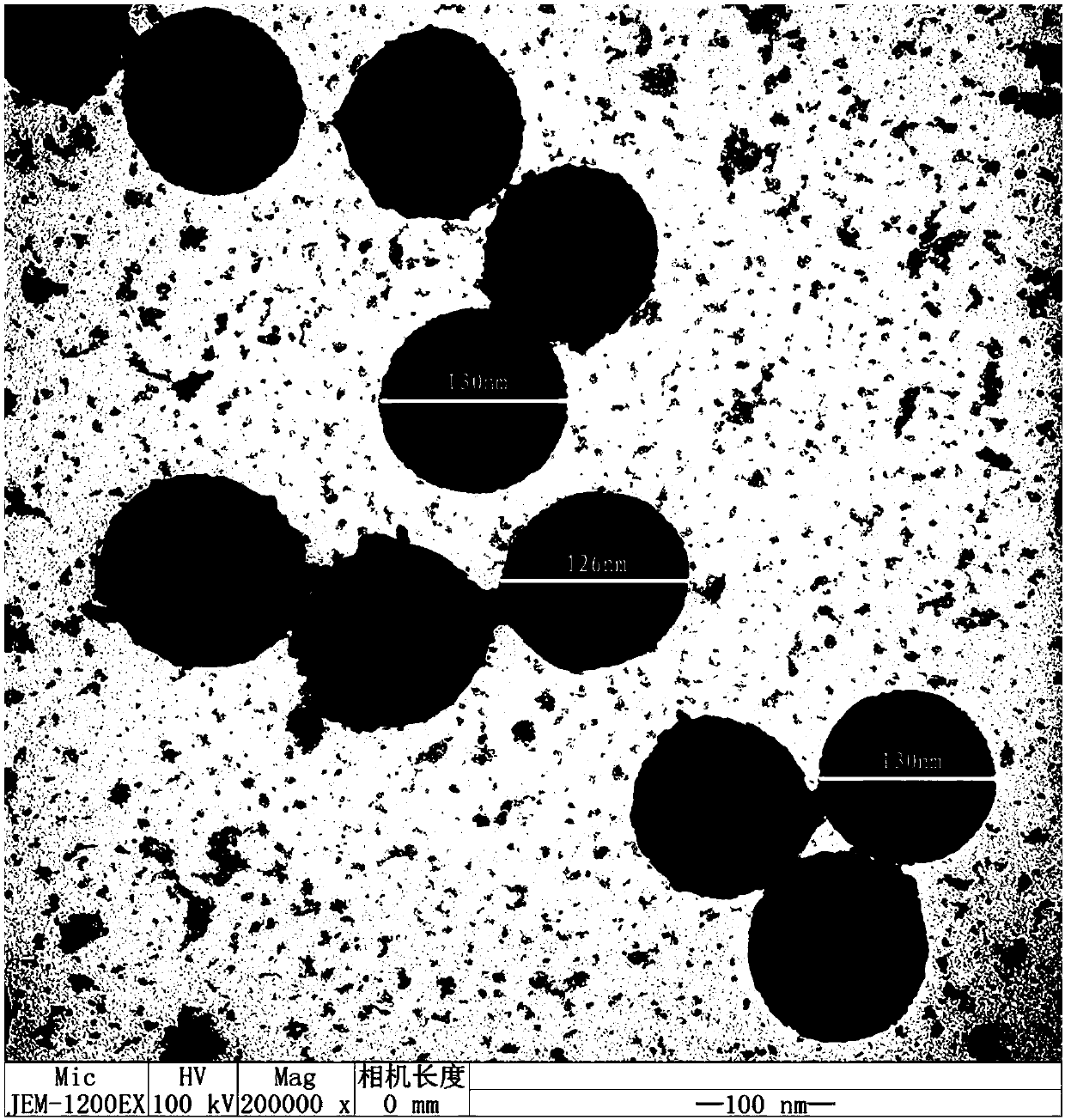A hybrid luminescent material formed by embedding a terbium complex in inorganic nanoparticles and a preparing method thereof
A technology of inorganic nanoparticles and luminescent materials, applied in luminescent materials, chemical instruments and methods, etc., can solve the incompatibility between preparation methods and microstructures, restrict the practical application of rare earth complexes, and thermally stable organic complexes problems such as poor reproducibility, to achieve the effect of strong repeatability, uniform particle size and stable product
- Summary
- Abstract
- Description
- Claims
- Application Information
AI Technical Summary
Problems solved by technology
Method used
Image
Examples
Embodiment 1
[0028] A method for preparing an inorganic nanoparticle-embedded terbium complex hybrid luminescent material, comprising the following steps:
[0029] (1) Pour 50ml of absolute ethanol solution into a 100ml Erlenmeyer flask, add 3ml of ammonia solution with a concentration of 25%, and mix the two fully and evenly under the condition of 500r / min magnetic stirring, and record the resulting solution as the reaction Solution 2, measure SiO 2 1.5ml of tetraethyl orthosilicate solution with a content of 28% was slowly poured into the mixed solution of the reaction solution 2, and continued to react for 24 hours under the same magnetic stirring as the above-mentioned rotating speed to obtain a nano-silica solution;
[0030] (2) Place a rotor with a length of 1cm in a 50ml Erlenmeyer flask, weigh 0.5g of tetraterbium heptoxide and add it to the Erlenmeyer flask, then add 4ml of 30% hydrogen peroxide, and then dropwise add 6ml of concentrated The aqueous solution of hydrochloric acid ...
Embodiment 2
[0036] A method for preparing an inorganic nanoparticle-embedded terbium complex hybrid luminescent material, comprising the following steps:
[0037] (1) Pour 50ml of absolute ethanol solution into a 100ml Erlenmeyer flask, add 1ml of ammonia solution with a concentration of 25%, and mix the two fully and evenly under the condition of 500r / min magnetic stirring, and record the resulting solution as the reaction Solution 3, measure SiO 2 1.5ml of tetraethyl orthosilicate solution with a content of 28% was slowly poured into the mixed solution of the reaction solution 3, and continued to react for 24 hours under the same magnetic stirring as the above-mentioned rotating speed to obtain a nano-silica solution;
[0038] (2) Place a rotor with a length of 1cm in a 50ml Erlenmeyer flask, weigh 0.5g of tetraterbium heptoxide and add it to the Erlenmeyer flask, then add 4ml of 30% hydrogen peroxide, and then dropwise add 6ml of concentrated The aqueous solution of hydrochloric acid ...
Embodiment 3
[0044] A method for preparing an inorganic nanoparticle-embedded terbium complex hybrid luminescent material, comprising the following steps:
[0045] (1) Pour 50ml of absolute ethanol solution into a 100ml Erlenmeyer flask, add 4ml of ammonia solution with a concentration of 25%, and mix the two fully and evenly under the condition of 500r / min magnetic stirring, and record the resulting solution as the reaction Solution 4, measure SiO 2 Slowly pour 1.5 ml of tetraethyl orthosilicate solution with a content of 28% into the mixed solution of reaction solution 4, and continue to react for 24 hours under the magnetic stirring at the same rotational speed as above;
[0046] (2) Place a rotor with a length of 1cm in a 50ml Erlenmeyer flask, weigh 0.5g of tetraterbium heptoxide and add it to the Erlenmeyer flask, then add 4ml of 30% hydrogen peroxide, and then dropwise add 6ml of concentrated The aqueous solution of hydrochloric acid (the volume ratio of hydrochloric acid to water ...
PUM
| Property | Measurement | Unit |
|---|---|---|
| particle diameter | aaaaa | aaaaa |
| particle diameter | aaaaa | aaaaa |
| particle diameter | aaaaa | aaaaa |
Abstract
Description
Claims
Application Information
 Login to View More
Login to View More - R&D
- Intellectual Property
- Life Sciences
- Materials
- Tech Scout
- Unparalleled Data Quality
- Higher Quality Content
- 60% Fewer Hallucinations
Browse by: Latest US Patents, China's latest patents, Technical Efficacy Thesaurus, Application Domain, Technology Topic, Popular Technical Reports.
© 2025 PatSnap. All rights reserved.Legal|Privacy policy|Modern Slavery Act Transparency Statement|Sitemap|About US| Contact US: help@patsnap.com

